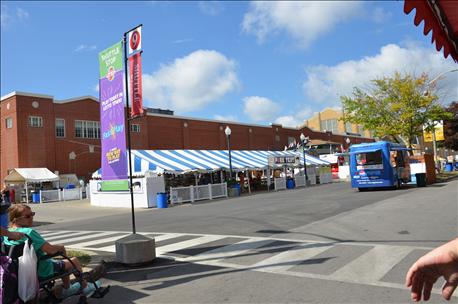
Overall, the 2015 Indiana State Fair was a success. The weather cooperated and there were good crowds, on certain days. The people behind the scenes at both the Indiana FFA Pavilion and Pioneer Village say that all in all, it was a very good fair with lots of traffic.
These same people say that perhaps the lightest day for traffic in their displays was Wednesday, Aug 19. That was the traditional Farmer's Day at the Indiana State Fair. I attended on Farmer's Day until mid-afternoon, and agree that crowds were extremely light.

Where is everybody? – Most of them were back in school. Early start days for school appears to hurt Farmer's Day attendance at the Indiana State Fair, and result in empty streets.
In general morning crowds were so light during the week that The Indiana Department of Natural Resources didn't hold their popular fishing activities for kids in the mornings during the week. They held them during the mornings on weekends, usually with kids waiting to fish, learn about fishing and catch real fish in a 'pond' near the DNR building.
When I was a teenager on the farm, the highlight of the summer was going to the Indiana State Fair. We piled four adults and five kids into a Chevy Impala – this was long before seat belts and car seats, and headed to the fair. More often than not, it was Farmer's Day. My parents and the other couple both farmed, and they wanted to see the parade and special events held on Farmer's day.
What I remember is waiting in line to park in the infield, eating lunch in the hot sun out of the trunk of the car, because the moms thought the fair vendors didn't keep things clean, and people – people everywhere.
So what's changed in 45 years? Who stole the Farmer's Day I remember? It doesn't take a rocket scientist to figure out that one of the most likely suspects are schools and early starting dates. We've talked about this before. Some reaction to our opposition to schools starting in July and early August agreed with us, others pointed out that there was logic in starting school earlier so students didn't forget as much over the summer. I'm still waiting to see hard data on that point.
If memory serves me correctly, in 1970 school started within a day or two after we made our annual trek to Farmers Day, not two or three weeks before. Going to the fair was like the last hooray of summer. Today it feels like fall is here, even though corn is only in the milk stage and soybeans are still hoping for rain to fill out pods.
Is that the only reason Farmers Day crowds are light? It's tough to say. The Indiana State Fair holds $2 Tuesdays, where admission is $2 and there are bargains on food. Reports indicate those are two of the biggest days of the fair. Why not $3 Wednesday or $4 Farmer's Day? Do people plan for the $2 bargain day instead of coming on Farmer's Day?
Farmer's Day still features many attractions, especially for those in agriculture. The parade was missing, but there was the Indiana Farm Bureau pancake breakfast, award ceremonies for River Friendly Farmers awards and more. But apparently none of that enticed farm families to pull kids out of school and come to the fair.
Would moving Farmer's Day up earlier in the fair when not every family has kids in school help? We don't know. We just think it's unfortunate that on the day of all days set aside to honor farmers, the backbone of Indiana agriculture and the history of the fair, few people show up to see it. We hope the Indiana State Fair Commission and Indiana State Fair Board will consider this for the future.
About the Author(s)
You May Also Like




